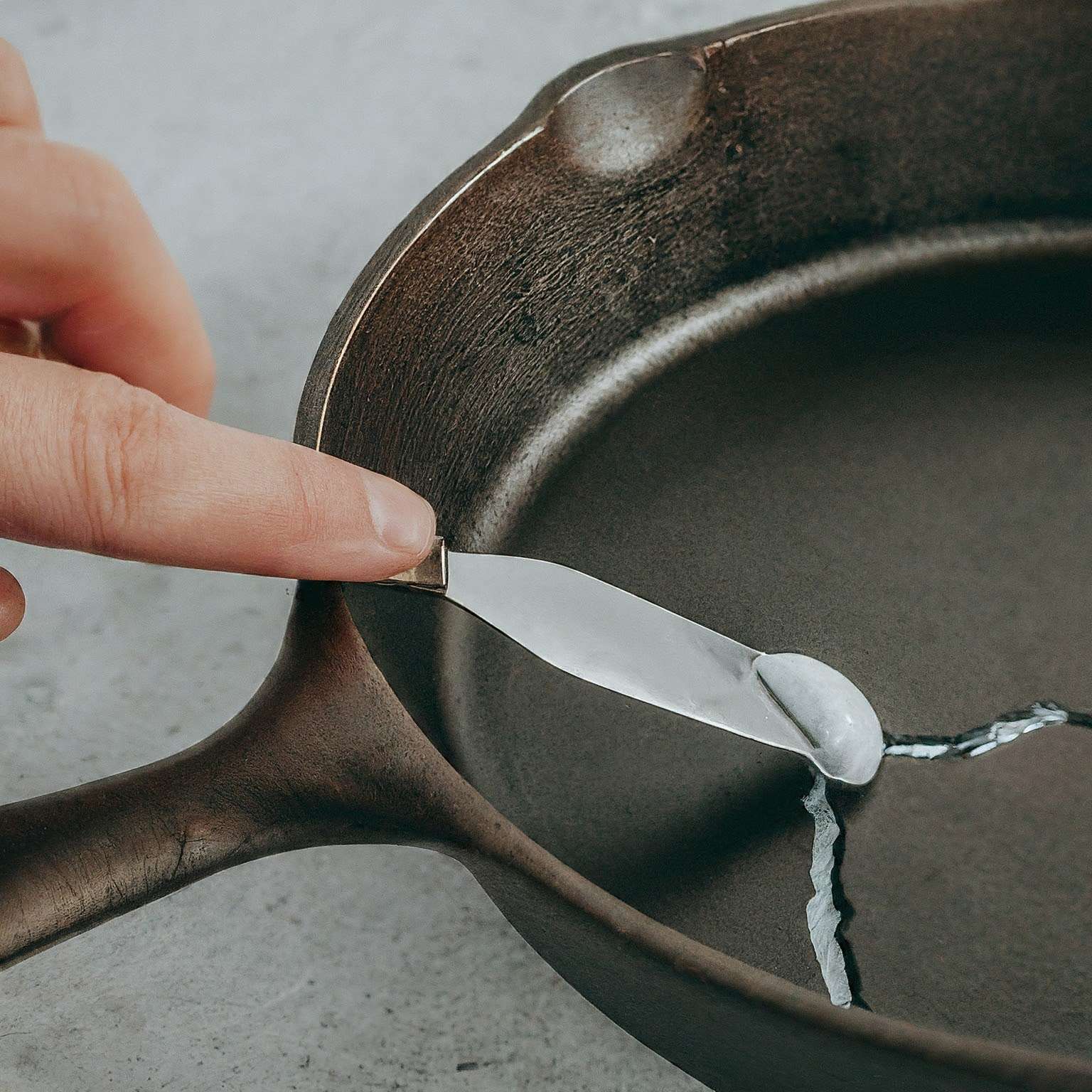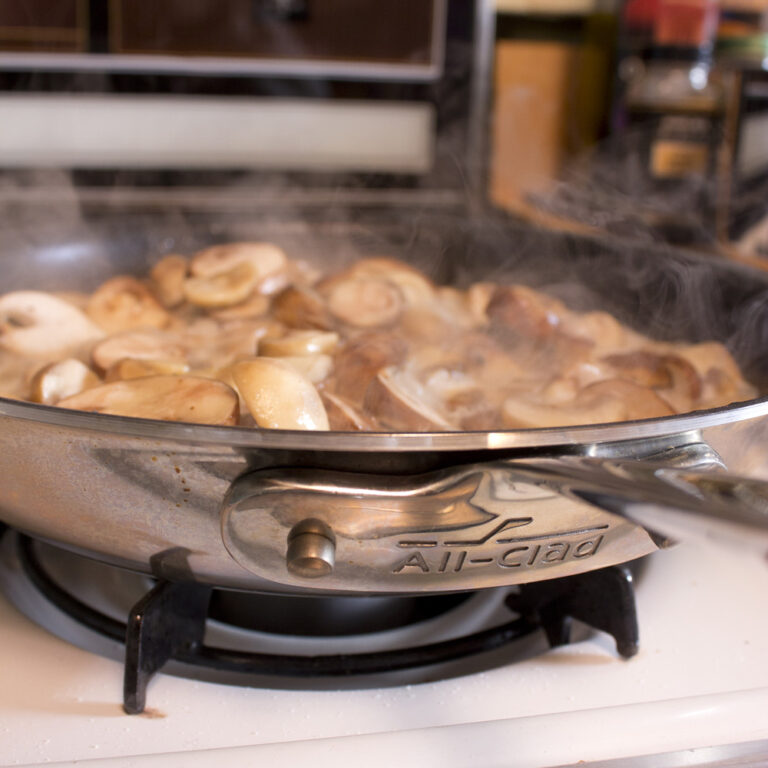I’ve always loved cooking with my trusty cast iron pan, but recently I noticed a crack in it.
It got me wondering: can cast iron pans really crack? And if they do, is there a way to fix them?
In this article, we’ll explore the signs of a cracked cast iron pan, the common causes of these cracks, and most importantly, how to repair them.
So if you’re facing a cracked cast iron pan dilemma like me, read on for some handy solutions!
Key Takeaways
- Cracks in cast iron pans can occur due to dropping the pan or extreme temperature changes.
- Assessing the severity of a crack involves examining its length, depth, and location.
- Small cracks can be repaired using epoxy (J-B Weld KwikWeld, 6 Minute Set Epoxy, Steel Reinforced Epoxy, High Strength), which creates a strong bond and restores functionality.
- Severely cracked cast iron pans may require professional repairs, such as metal stitching, for strong and durable restoration.
Signs of a Cracked Cast Iron Pan
If you notice a crack in your cast iron pan, it’s best to stop using it to prevent any further damage. Cracks can occur due to various reasons, such as dropping the pan or extreme temperature changes.
Repairing cast iron pans is possible, but prevention is always better than cure. Regular maintenance tips can help prolong the lifespan of your cast iron pan and avoid cracks altogether. One important tip is to season your pan regularly with oil to keep it well protected from rust and maintain its non-stick surface.
Additionally, avoid sudden temperature changes by allowing the pan to cool down gradually before cleaning or storing it. Taking these simple steps will ensure that your cast iron pan stays crack-free for years to come.
Common Causes of Cast Iron Pan Cracks
One common cause of cracks in your cast iron pan is subjecting it to extreme temperature changes. When you expose a hot cast iron pan to cold water or vice versa, the sudden change in temperature can cause the pan to expand or contract rapidly, leading to cracks. To avoid this, always allow your cast iron pan to cool down naturally before cleaning it.
Another factor that can contribute to cracks is overheating the pan. Excessive heat can weaken the structure of the cast iron and make it more susceptible to cracking. To prevent this, use low or medium heat when cooking with your cast iron pan and avoid leaving it on high heat for extended periods of time.
Taking these precautions will help keep your beloved cast iron pan crack-free and ensure its longevity in your kitchen.
Assessing the Severity of a Crack
Assessing the severity of a crack can be done by carefully examining its length, depth, and location on the cast iron pan. When evaluating damage, it’s crucial to look for any signs of widening or extending cracks.
A longer crack generally indicates a more severe issue compared to shorter ones. The depth of the crack is also essential since deeper cracks may affect the structural integrity of the pan, making it more challenging to repair.
Additionally, considering the location of the crack is vital in determining repair options. Cracks near handles or edges are more prone to spreading due to stress concentration points.
Repairing Small Cracks in a Cast Iron Pan
When repairing small cracks in your cast iron pan, start by thoroughly cleaning the area around the damaged spot. This will ensure that the epoxy adheres properly and provides a strong bond. Once the area is clean, you can assess whether the crack is deep or shallow. If it’s a deep crack, using epoxy for repairs is an effective solution. Epoxy is a durable adhesive that can fill in the crack and create a seamless surface. To give you an idea of how effective epoxy can be, here’s a table showcasing its benefits:
| Benefits of Using Epoxy for Cast Iron Pan Repairs |
|---|
| Strong and long-lasting bond |
| Resistant to heat and moisture |
| Easy to apply |
| Can be sanded and painted over |
| Restores the functionality of your pan |
Using epoxy not only fixes small cracks but also extends the lifespan of your beloved cast iron pan.
Restoring Severely Cracked Cast Iron Pans
To restore severely cracked cast iron pans, it’s important to consider the extent of the damage and whether repair is feasible. In some cases, restoring these pans can be a challenging task.
However, there are techniques that can help bring them back to their former glory. One option is to use a process called metal stitching, where professionals use specialized tools and techniques to repair the cracks by stitching them together with metal rods. This method requires skill and precision but can result in a strong and durable restoration.
Another approach is to seek professional repairs, where experts have the knowledge and experience to assess the damage accurately and apply appropriate techniques for fixing it. While this may come at a cost, it ensures that your cast iron pan receives proper care and attention, giving you peace of mind knowing it has been restored professionally.
Preventing Cracks in Cast Iron Pans
When it comes to preventing cracks in cast iron pans, proper heating techniques and seasoning are key.
I’ve learned from experience that gradually increasing the heat when cooking with a cast iron pan helps to prevent thermal shock and potential cracking.
Additionally, regularly seasoning the pan not only enhances its durability but also creates a protective layer that prevents moisture from seeping into the iron and causing cracks.
Proper Heating Techniques
Make sure you’re preheating your cast iron pan slowly and evenly to prevent cracking. When it comes to heating temperature, it’s crucial to follow the right approach. Here are three key points to keep in mind:
- Gradual Heat: Start by setting your stove or oven to a low heat setting and let the pan warm up gradually. This allows the cast iron to expand uniformly, reducing the risk of cracks.
- Even Distribution: Ensure that the heat is distributed evenly across the entire surface of the pan. To achieve this, place your cast iron pan on a burner that matches its size or use an oven with consistent heat distribution.
- Patience is Key: Don’t rush the preheating process; give your cast iron pan enough time to reach the desired temperature before adding any ingredients or food.
Seasoning for Durability
Now that we’ve discussed proper heating techniques, let’s move on to the next important step in maintaining cast iron pans: seasoning for durability.
Seasoning is a process that helps create a protective layer on the surface of the pan, preventing rust and enhancing its non-stick properties. The key to successful seasoning is choosing the right oils.
When it comes to cast iron, oils with high smoke points are best for seasoning. These include vegetable oil, canola oil, and flaxseed oil. These oils can withstand high heat without breaking down or leaving a sticky residue on your pan.
Conclusion
In conclusion, cast iron pans can indeed crack, but there are ways to fix them.
It is important to look for signs of cracks and assess their severity before attempting any repairs.
Small cracks can be fixed using methods like welding or soldering, while severely cracked pans may need professional restoration.
However, the best approach is to prevent cracks from occurring in the first place by properly seasoning and caring for your cast iron pan.
With proper maintenance, your cast iron pan will continue to serve you well for years to come.
Additonal Resourecs

